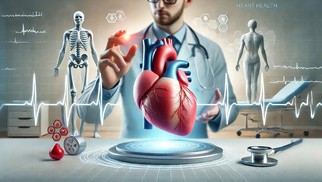Tachyarrhythmia: Causes, Symptoms, and Treatment


Tachyarrhythmia is a term used to describe a group of cardiac arrhythmias characterized by an abnormally fast heart rate. While a normal resting heart rate ranges from 60 to 100 beats per minute (bpm), tachyarrhythmias involve heart rates exceeding 100 bpm, often with irregular electrical activity in the heart. This condition can have various causes, including structural heart disease, electrolyte imbalances, ischemic heart conditions, and genetic predispositions. Understanding tachyarrhythmia is crucial for effective diagnosis, management, and treatment, particularly with pharmacological agents like Lanoxin (digoxin).
Understanding Tachyarrhythmia
Tachyarrhythmias arise when there is a disruption in the heart’s normal electrical conduction system, which governs the rhythmic contraction of cardiac muscle. These arrhythmias can originate in different parts of the heart, including the atria, the atrioventricular (AV) node, or the ventricles.
Broadly, tachyarrhythmias are classified into two main types: supraventricular tachyarrhythmias and ventricular tachyarrhythmias. Supraventricular tachyarrhythmias originate above the ventricles, usually involving the atria or the AV node, while ventricular tachyarrhythmias arise from the lower chambers of the heart. The latter type is often more serious, as it can lead to hemodynamic instability and sudden cardiac death.
Difference Between Tachyarrhythmia and Sinus Tachycardia
Although tachyarrhythmia refers to any fast and abnormal heart rhythm, sinus tachycardia is a specific condition characterized by a fast but regular heart rhythm originating from the sinoatrial (SA) node, the natural pacemaker of the heart. Sinus tachycardia is usually a physiological response to factors such as fever, exercise, stress, dehydration, or anemia. It does not represent an intrinsic cardiac disease but rather a response to external stimuli.
Tachyarrhythmia, on the other hand, includes abnormal rhythms that may arise from ectopic foci (abnormal electrical impulses) or reentrant circuits within the heart. These abnormal rhythms can be pathological and may require medical intervention, unlike sinus tachycardia, which typically resolves when the underlying cause is addressed.
The Most Common Type of Tachyarrhythmia
Atrial fibrillation (AF) is the most common type of tachyarrhythmia. It is a supraventricular arrhythmia characterized by rapid, disorganized electrical activity in the atria, leading to an irregular and often rapid ventricular response. AF significantly increases the risk of stroke, heart failure, and other cardiovascular complications. The prevalence of AF increases with age and is associated with risk factors such as hypertension, diabetes, obesity, and chronic heart disease.
In atrial fibrillation, the normal coordinated contraction of the atria is lost, resulting in ineffective blood flow to the ventricles. This inefficiency can lead to blood stasis in the atria, predisposing patients to thrombus formation and increasing the risk of embolic events such as ischemic stroke.
Mechanism of Tachyarrhythmias
The development of tachyarrhythmias can be attributed to three main mechanisms: increased automaticity, triggered activity, and reentry circuits.
Increased automaticity refers to an abnormal increase in the firing rate of a pacemaker cell within the heart, which can result in premature or ectopic beats. This can occur due to electrolyte imbalances, ischemia, or excessive stimulation of the sympathetic nervous system.
Triggered activity arises when early or delayed afterdepolarizations cause abnormal electrical impulses. These premature impulses can initiate sustained tachyarrhythmias under specific conditions, such as long QT syndrome or digitalis toxicity.
Reentry circuits, the most common cause of tachyarrhythmias, occur when an electrical impulse continuously cycles through a loop within the heart tissue. This can result from areas of slowed conduction or unidirectional block, allowing for the establishment of a self-perpetuating circuit. Reentrant tachyarrhythmias include atrial flutter, AV nodal reentrant tachycardia (AVNRT), and ventricular tachycardia.
Diagnosis and Clinical Presentation
The clinical presentation of tachyarrhythmias varies depending on the type, duration, and severity of the arrhythmia. Some patients remain asymptomatic, while others experience palpitations, dizziness, syncope, chest pain, or shortness of breath. In severe cases, tachyarrhythmias can cause hemodynamic collapse, leading to hypotension, heart failure, or cardiac arrest.
Diagnosis involves a thorough clinical evaluation, including history-taking, physical examination, and electrocardiographic (ECG) monitoring. A standard 12-lead ECG is the primary tool for identifying tachyarrhythmias, revealing characteristic patterns such as irregularly irregular rhythms in atrial fibrillation or wide QRS complexes in ventricular tachycardia. Additional diagnostic tests, including Holter monitoring, echocardiography, and electrophysiological studies, may be required to determine the underlying cause and guide treatment.
Treatment Approaches
The management of tachyarrhythmias depends on the underlying cause, type of arrhythmia, and clinical status of the patient. Treatment strategies include rate control, rhythm control, and prevention of thromboembolic complications.
Rate control is often achieved with medications such as beta-blockers, calcium channel blockers, and digoxin, which slow the ventricular response in supraventricular tachyarrhythmias. Rhythm control aims to restore normal sinus rhythm using antiarrhythmic drugs, electrical cardioversion, or catheter ablation.
Anticoagulation therapy is a key component of atrial fibrillation management to reduce the risk of stroke. Patients with a high thromboembolic risk, as determined by the CHA2DS2-VASc score, are prescribed anticoagulants such as warfarin or direct oral anticoagulants (DOACs).
The Role of Lanoxin (Digoxin) in Treatment
Lanoxin, the brand name for digoxin, is a cardiac glycoside that has been used for decades in the management of tachyarrhythmias, particularly atrial fibrillation and atrial flutter. Its primary mechanism of action involves inhibition of the sodium-potassium ATPase pump, leading to increased intracellular calcium concentrations. This enhances cardiac contractility (a positive inotropic effect) and prolongs AV node conduction time, ultimately reducing the ventricular response in supraventricular tachyarrhythmias.
The use of digoxin is particularly beneficial in patients with heart failure and atrial fibrillation, as it helps control the heart rate without causing significant hypotension. However, it is generally not the first-line treatment for AF rate control, as beta-blockers and calcium channel blockers are often preferred. Digoxin has a narrow therapeutic index, meaning that careful monitoring of serum levels is necessary to avoid toxicity, which can manifest as nausea, vomiting, visual disturbances, and life-threatening arrhythmias.
While digoxin is effective in slowing ventricular rate, it does not convert atrial fibrillation to normal sinus rhythm. Therefore, it is commonly used in conjunction with other antiarrhythmic agents or anticoagulation therapy to reduce the risk of thromboembolic complications.
Conclusion
Tachyarrhythmia encompasses a diverse group of arrhythmic conditions characterized by an abnormally rapid heart rate. Unlike sinus tachycardia, which is a normal physiological response, tachyarrhythmias often involve pathological disruptions in the heart’s electrical activity. Among these, atrial fibrillation is the most prevalent and carries significant clinical consequences. The underlying mechanisms of tachyarrhythmias include increased automaticity, triggered activity, and reentry circuits.The management of tachyarrhythmias involves multiple therapeutic approaches, including rate and rhythm control, anticoagulation, and electrophysiological interventions. Lanoxin (digoxin) plays a valuable role in rate control, particularly in patients with heart failure and atrial fibrillation. However, due to its narrow therapeutic window and potential for toxicity, its use requires careful monitoring. Understanding tachyarrhythmia and its treatment strategies is essential for optimizing patient outcomes and preventing complications associated with abnormal heart rhythms.
Medically Reviewed by Dr. Rabeea Aboufakher, MD
(Updated at Mar 27 / 2025)